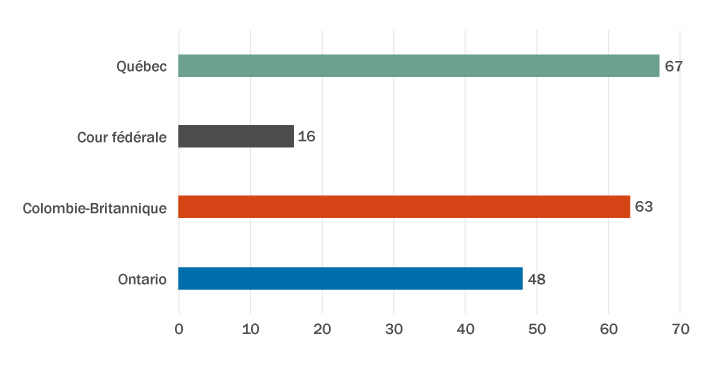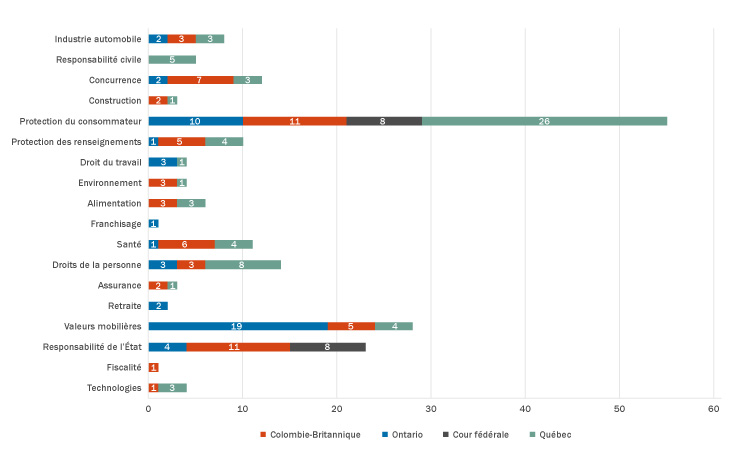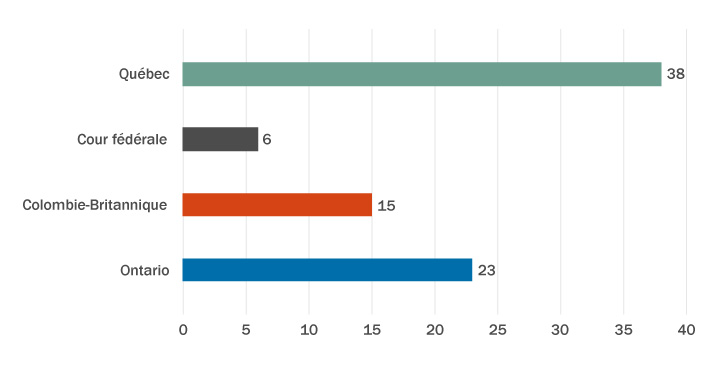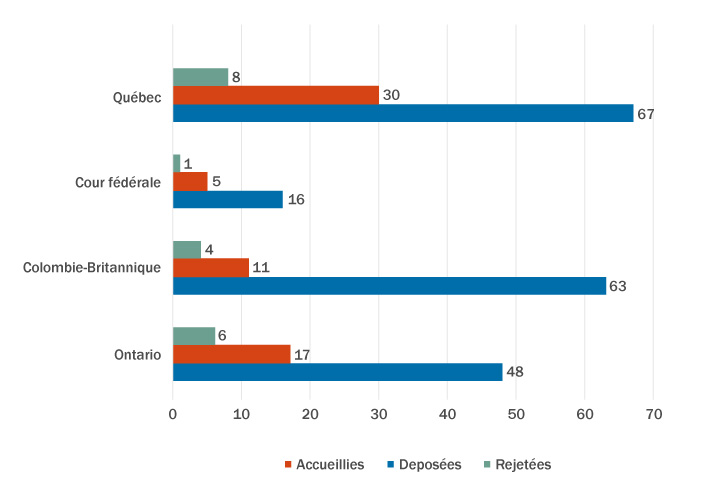Actions collectives au Canada : revue de l’année 2024
Auteurs
 Anne Merminod
Anne Merminod Karl Boulanger
Karl Boulanger Sarah E. Whitmore
Sarah E. Whitmore Alexandra Lawrence
Alexandra Lawrence
Roxanne Beaucage

Marisa Benjamin
Les actions collectives ont continué de façonner le paysage juridique canadien en 2024. Dans ce bulletin, nous nous penchons sur les statistiques clés en matière d’actions collectives dans les juridictions les plus actives dans le milieu au Canada, soit le Québec, la Colombie-Britannique et l’Ontario, ainsi que la Cour fédérale, et analysons les grandes tendances de l’année et les domaines les plus ciblés1.
Statistiques et tendances à surveiller
Des tendances marquantes ont émergé l’année dernière :
- Le Québec demeure la juridiction la plus active en matière d’actions collectives au Canada. En effet, 35 % des nouveaux dossiers d’actions collectives en 2024 ont été déposés au Québec, suivi de près par la Colombie-Britannique et l’Ontario.
- Le nouveau visage des actions collectives liées au numérique. On observe une hausse des recours contre les plateformes de services en ligne et des recours liés à la protection des renseignements personnels. Les actions collectives en matière d’IA font aussi leur apparition au Canada, avec la première action collective en IA autorisée au Québec et une action inédite déposée en Colombie-Britannique (pour en savoir plus à ce sujet, lisez notre article « L’IA de plus en plus visée par des actions collectives »).
- Seuils de certification et d’autorisation peu élevés. Les seuils de certification et d’autorisation se sont révélés peu élevés de nouveau cette année. En effet, 75 % des demandes ont été accueillies, avec des seuils de certification et d’autorisation de presque 80 % au Québec et à la Cour fédérale.
- Émergence des recours liés aux SPFA. Les SPFA, des substances chimiques dites « éternelles », font leur entrée dans le milieu des actions collectives au Canada après avoir déferlé aux États-Unis.
Actions collectives proposées et demandes d’autorisation
Graphique 1 : Actions collectives proposées et demandes d’autorisation

L’activité a été soutenue tout au long de l’année, avec environ 17 nouvelles demandes d’actions collectives déposées chaque mois. Les mois de juin et de novembre ont été particulièrement actifs, avec respectivement 23 (dont 12 au Québec) et 28 demandes déposées (dont 13 en Colombie-Britannique).
Pas moins de 194 actions collectives proposées (et demandes d’autorisation au Québec) ont été déposées : le Québec est en tête avec 67 demandes, suivi de près par la Colombie-Britannique (63), l’Ontario (48) et la Cour fédérale (16).
Principaux domaines visés
Graphique 2 : Actions collectives proposées et demandes d’autorisation, par secteur

Plusieurs secteurs se sont démarqués dans les dossiers d’actions collectives déposés en 2024 :
- Droit de la consommation : Les actions collectives en droit de la consommation dominent toujours, représentant près de 33 % du total des actions déposées. Le Québec demeure particulièrement visé par ces demandes, concentrant près de la moitié des dossiers dans le domaine au sein des juridictions concernées. À la Cour fédérale, ces recours représentent la moitié des demandes déposées.
- Valeurs mobilières : Les actions collectives en valeurs mobilières, un des rares domaines où la législation est harmonisée partout au Canada, représentent près de 15 % de toutes les demandes déposées en 2024. L’Ontario est de loin la province la plus active, accueillant près de 70 % des dossiers.
- Protection des renseignements personnels : Représentant 10 demandes en 2024, les dossiers alléguant une brèche de sécurité des données ou une utilisation non autorisée de renseignements personnels demeurent en forte progression.
En plus des secteurs ci-dessus (voir le graphique 2), nous avons identifié quelques secteurs qui ont été particulièrement ciblés par des dossiers d’actions collectives en 2024 :
- Responsabilité du fait du produit : L’industrie automobile et le secteur pharmaceutique ont été particulièrement ciblés, principalement au Québec et en Colombie-Britannique.
- Services en ligne : Les plateformes de commerce et de livraison en ligne ont continué d’être la cible d’actions collectives en 2024, représentant près de 10 % des nouvelles actions collectives, dont la moitié au Québec.
- SPFA : Une tendance américaine s’installe au Canada avec les premiers recours déposés contre des fabricants pour la contamination alléguée par des substances perfluoroalkylées et polyfluoroalkylées (SPFA), décrites comme des « produits chimiques éternels ».
- COVID-19 : Bien que la pandémie se soit résorbée il y a quelque temps, elle fait encore l’objet de nouvelles actions collectives déposées en Ontario et devant la Cour fédérale.
Décisions de certification et d’autorisation
Graphique 3 : Décisions de certification et d’autorisation

Les tribunaux ont été bien actifs en 2024, avec un total de 82 décisions de certification et d’autorisation rendues, soit une moyenne de sept jugements par mois. Le Québec était en tête avec 38 décisions, suivi de l’Ontario (23), de la Colombie-Britannique (15) et de la Cour fédérale (6) (voir le graphique 3). En outre, les seuils de certification et d’autorisation peu élevés continuent de favoriser les demandeurs, puisque 75 % des décisions ont mené à la certification ou à l’autorisation des recours, ce qui représente 63 nouvelles actions collectives certifiées ou autorisées dans les quatre juridictions concernées (voir le graphique 4). Ce taux varie entre 73 % en Colombie-Britannique et 83 % à la Cour fédérale.
Graphique 4 : Demandes d’actions collectives accueillies et rejetées

- Les statistiques ont été recensées en date du 18 février 2025, à l’aide de banques de données publiquement disponibles. Au Québec, le Registre des actions collectives, CanLii et les plumitifs ont été consultés, alors qu’en Ontario, Colombie-Britannique et la Cour fédérale, la Base de données nationale sur les actions collectives, Ontario Justice Services, Online Court Portal, Ontario Class Action Database, CanLii, Lexis+ Canada et Westlaw Canada ont été consultés. Les statistiques en Ontario, Colombie-Britannique et la Cour fédérale sont soumises aux limitations inhérentes de la Base de données nationale sur les actions collectives, qui ne peut garantir des résultats de recherche exhaustifs comme elle dépend des soumissions volontaires des avocats à travers le Canada.
Si vous souhaitez discuter ces enjeux et ces questions, veuillez contacter les auteurs.
Cette publication se veut une discussion générale concernant certains développements juridiques ou de nature connexe et ne doit pas être interprétée comme étant un conseil juridique. Si vous avez besoin de conseils juridiques, c'est avec plaisir que nous discuterons les questions soulevées dans cette communication avec vous, dans le cadre de votre situation particulière.
Pour obtenir la permission de reproduire l’une de nos publications, veuillez communiquer avec Janelle Weed.
© Torys, 2025.
Tous droits réservés.